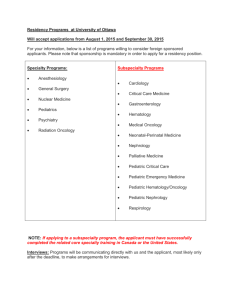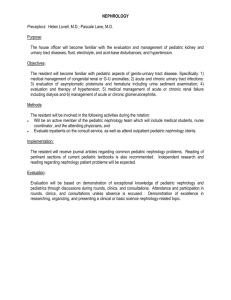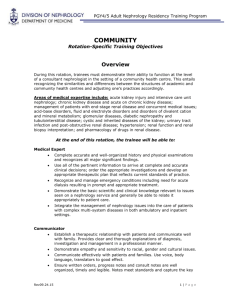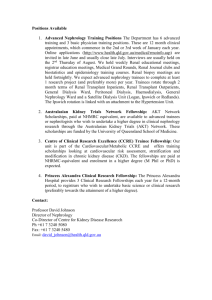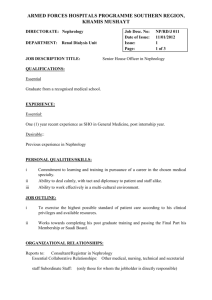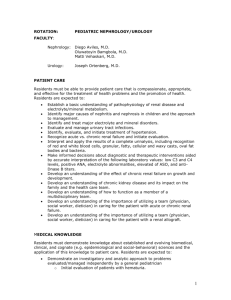Coordination of Adult and Pediatric Subspecialty Programs
advertisement
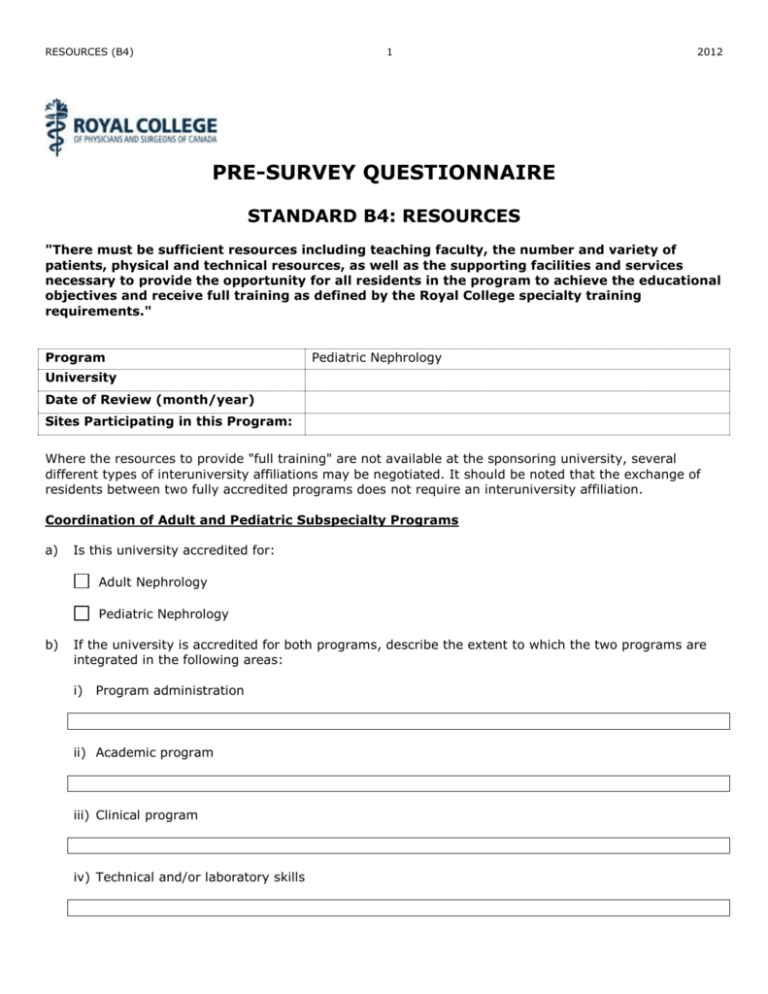
RESOURCES (B4) 1 2012 PRE-SURVEY QUESTIONNAIRE STANDARD B4: RESOURCES "There must be sufficient resources including teaching faculty, the number and variety of patients, physical and technical resources, as well as the supporting facilities and services necessary to provide the opportunity for all residents in the program to achieve the educational objectives and receive full training as defined by the Royal College specialty training requirements." Program Pediatric Nephrology University Date of Review (month/year) Sites Participating in this Program: Where the resources to provide "full training" are not available at the sponsoring university, several different types of interuniversity affiliations may be negotiated. It should be noted that the exchange of residents between two fully accredited programs does not require an interuniversity affiliation. Coordination of Adult and Pediatric Subspecialty Programs a) Is this university accredited for: Adult Nephrology Pediatric Nephrology b) If the university is accredited for both programs, describe the extent to which the two programs are integrated in the following areas: i) Program administration ii) Academic program iii) Clinical program iv) Technical and/or laboratory skills RESOURCES (B4) 2 2012 1. Teaching Faculty List by teaching site the members of the teaching faculty who have a major role in this program, including members from other departments. In indicating a subspecialty, use as a criterion whether he or she is considered by colleagues as a subspecialist and functions academically and professionally as one. Teaching Site Name University Rank Specialty Qualifications What percentage of faculty listed above have been practising in the subspecialty: < 15 years % > 25 years % Subspecialty (If any) Nature of Interaction with Resident (e.g. clinical, teaching, research) RESOURCES (B4) 3 2012 Provide quantitative data documenting the volume and variety of patients available for teaching in each of the clinical areas listed below. Complete one table for each training site used for Nephrology resident education. Briefly (2-3 sentences) describe how these resources are used for Nephrology resident teaching. 2. Inpatient (Statistics for most recent 12-month period – Dates: ) SITE ► Admissions to Nephrology Visits in day hospital Inpatient consults Note : It is recognized that not all training programs have an inpatient Nephrology service. Briefly describe (2-3 sentences) how these resources are used for residency training. Briefly describe (2-3 sentences) the resident’s involvement in the initial assessment and management of emergencies involving renal disorders. 3. Ambulatory (Statistics for most recent 12-month period – Dates: ) SITE ► Outpatient new consult visits Outpatient follow-up clinic visits Briefly describe (2-3 sentences) how these resources are used for residency training. What is the resident’s experience in providing continuity of patient care? 4. Transplant (Statistics for most recent 12-month period – Dates: ) SITE ► Transplants performed Recipient assessments for transplant Prevalent transplant patients followed Briefly describe (2-3 sentences) how these resources are used for residency training. 5. Dialytic Therapies (Statistics for most recent 12-month period – Dates: ) RESOURCES (B4) 4 2012 SITE ► Number/ Yr Number of treatment days/yr Number/ Yr Number of treatment days/yr Number/ Yr Number of treatment days/yr Acute dialysis (includes all modalities:CRRT, HD, PD, SLED etc.) New PD patients Total PD patients New Chronic HD Patients Total HD patients CRRT = continuous renal replacement therapies such as chronic veno-venous hemodiafiltration HD = hemodialysis PD = peritoneal dialysis SLED = slow low efficiency dialysis Briefly describe (2-3 sentences) how these resources are used for residency training. 6. Intensive Care Unit Complete the following set of questions for each training site that has an ICU (describe NICU and PICU in separate sections). SITE ► Does the Nephrology service see patients (consults etc.) in this ICU? Does the Nephrology service prescribe RRT in this ICU? Yes No Yes No Yes No Yes No Yes No Yes No Briefly describe (2-3 sentences) how these resources are used for residency training. 7. Pathology Please include all renal biopsy specimens that are reviewed by the pathologists in your facility (i.e including those referred in from other locations). (Statistics for most recent 12-month period – Dates: ) SITE ► Native kidney biopsies Transplant kidney biopsies Briefly describe (2-3 sentences) the residents’ exposure to the interpretation of renal biopsies. 8. Other RESOURCES (B4) 5 2012 List and briefly describe other resources used for regularly available electives (eg. community electives, adult Nephrology electives, specialty outpatient clinics such as stone, vascular access clinics etc.). 9. Supporting Services Is there a microscope and centrifuge readily available for resident use in the performance of urinalysis? Yes No Is there an immunology laboratory supporting the investigation and management of renal disorders and transplantation? Yes No Is there a General Surgery service? Yes No Is there a Urology service? Yes No 10.Evaluation and Monitoring of Resource Limitations What are the clinical areas in which resources may be limited for resident training? How does the program monitor and ensure that residents have adequate exposure to these clinical areas? (e.g. system of regular review, procedure logs, portfolios etc.) 11. Information Resources a) Do residents have free 24/7 access to on-line libraries, journals and other educational resources? Yes No Partially If “No” or “Partially”, please explain. b) Do residents have adequate space to carry out their daily work? Yes No c) Are technical resources required for patient care duties located in the work setting? Yes No d) Do facilities allow resident skills to be observed and do they allow for confidential discussions? Yes No 12.Summary of Adequacy of Resources Comment on the adequacy of the resources in the overall clinical program, with particular reference to the relationship between such resources and the number of residents dependent upon them. Include consideration of the following questions: Are there significant areas where the workload of the teachers (clinical care, undergraduate teaching, etc.) is such as to affect adversely the continuous supervision and instruction of residents in pediatric Nephrology? RESOURCES (B4) 6 Are the numbers of patients available for teaching sufficient to provide for the training of residents rotating from other residency programs and services, without adverse effects on the training of residents in pediatric Nephrology? Are the diagnostic and basic science facilities available to the program sufficient to provide adequate teaching and experience for residents in pediatric Nephrology in addition to other residents sharing the same facilities? Editorial revisions - February 2012 2012
